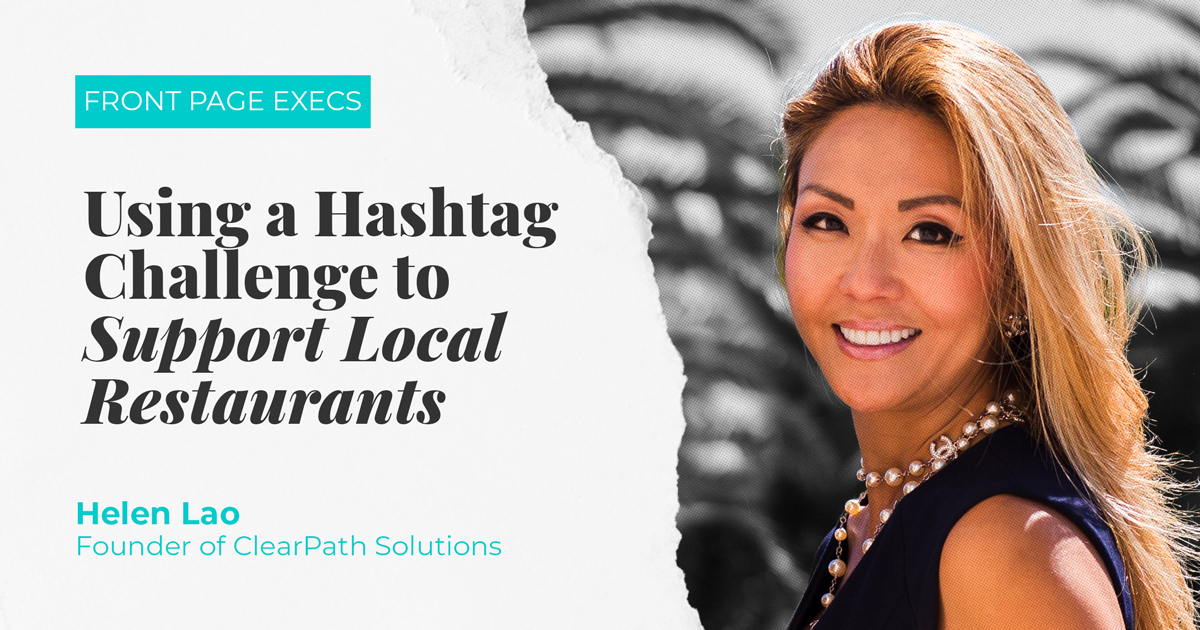In the last two weeks, executives have been flooding social media to participate in the latest hashtag challenge. The initiative is called #StepUpToTheTable and aims to support restaurants that have been impacted by the COVID-19 pandemic.
During the pandemic, the restaurant industry was among the hardest hit as dine-in services were severely affected or completely restricted due to lockdowns. In fact, according to the National Restaurant Association, 17% of all restaurants in the U.S. are now closed, with more expected as the pandemic continues.
The #StepUpToTheTable initiative asks social media users to support struggling restaurants by buying from them and spreading the word to support others in the industry. Executives should view hashtag challenges like this one as an avenue to improve their own social impact: taking part in it actively helps to give back to local communities, it raises widespread awareness by encouraging users to tag their own connections, and has the potential to make a positive social difference on a large-scale level.
The #StepUpToTheTable Challenge
#StepUpToTheTable was started by Helen Lao, the founder and president of ClearPath Solutions, an executive search firm that has been serving the restaurant industry for almost a decade. Launched on December 11, 2020, the challenge consists of three parts: first, participants are asked to buy gift cards or pick up a meal from their favorite restaurant. Next, they share their experience on social media using the #StepUpToTheTable hashtag. Lastly, they challenge others to do the same by tagging them in the post.
The structure of this hashtag challenge is effective for garnering awareness about the cause. Its rules require users to actively contribute by going out and buying from a restaurant. Next, it requires users to tag other people—such as friends, family, or people within their network—to take part in the challenge. This creates a chain effect, which is ideal for garnering more reach and awareness to the cause.
Since the initiative’s launch, many executives on social media have taken part in the challenge.
Using LinkedIn to Reach a Large Network of Executives
LinkedIn is a professional networking platform, making it an effective channel for reaching executives.
Lao began the challenge by leveraging her own LinkedIn connections and encouraging fellow leaders to use their platforms to highlight this initiative. Over the last two weeks, she has been actively keeping up with its status and has dedicated her entire LinkedIn feed to the #StepUpToTheChallenge initiative. By consistently highlighting key messaging on social media, executives can ensure their followers see the content.
Whether through reshares of other executives’ content or original videos where she outlines the rules and tags new executives each time, Lao posts about the initiative multiple times every day, which helps continue its momentum. Her current feed ensures that followers don’t have to sift through many posts to understand the challenge’s rules and goals. Here’s an example of the videos she is posting:
Lao is also using this opportunity to highlight how other executives are making contributions beyond the challenge’s initial goals, such as this post that highlights CEO Kurt Schnaubelt.
In maintaining this strong online presence, she positions herself as an executive who is actively dedicated to making a positive difference.
Another executive taking part in the challenge is Tom Bené, the CEO of the National Restaurant Association. He has also made multiple posts since being challenged by Lao. As a leader in a related industry, it is important for executives like Bene to take part in the challenge to both leverage their network and position themselves as a positive example to customers. Here is one example:
Bené has also made multiple video posts showcasing other restaurants and tagging other executives. His posts are an example of how to do the challenge correctly: he includes a video that shows his followers the gift cards he bought, he clearly states which restaurant he has chosen, he encourages users to take part in the challenge, and he correctly tags the executive who he has challenged as well as their company. Bené is an example of an executive who is both directly related to the restaurant industry and is taking initiative by continually taking part in the challenge.
However, it’s also worth noting that the challenge has made it to other industries such as the technology, financial, and retail sectors, which effectively shows how far social media’s reach can be. Some other examples of executives in other industries who are partaking in the challenge effectively are Marshall Warkentin, Rob Grimes, and Justin Otsuka.
While #StepUpToTheChallenge is also present on Twitter and Instagram, we believe LinkedIn is better suited for increasing awareness about this particular challenge since it heavily targets executives. As well, since CEOs and high-level executives are more likely to be on LinkedIn than other social platforms due to its professional networking nature, this means that the challenge is more likely to reach these users on LinkedIn than Twitter. Many of these users have built a large following, which helps to increase audience reach.
You can find all of the posts under the #StepUpToTheTable hashtag on LinkedIn here.
Factors to Consider When Participating in Hashtag Challenges
For executives who are interested in taking part in a social media hashtag challenge, it’s extremely important to pay attention to the challenge’s rules. Making sure to include the right hashtag in your post copy and spell it correctly also ensures discoverability.
One of the most important elements of #StepUpToTheTable is to tag other people in the copy. This notifies the tagged user of your content. However, we found that some executives forgot to tag other people or mention the name of the restaurant(s) they chose. For example, in this post by Greg Bertrand, he does not tag executives he wants to take part in the challenge—instead, he tags Tom Bené, who initially challenged him. Executives on social media should take note that in a challenge like this one, the purpose of tagging others is to increase awareness and audience reach.
Another factor for executives to consider is making their social media content accessible for all audiences. For example, in this post by Robb MacKie, he mentions his chosen restaurant’s name in the video but doesn’t include its name in the post copy. Executives should consider either including closed captioning in their videos or include important information both in the video and post copy. This will help make posts accessible for followers who are hearing or visually impaired or just have their volume turned down. In addition, tagging the restaurant (if the business is on the social media platform) can help drive followers to discover that brand.
Social media is a great way to raise awareness on a global level, and hashtag challenges are a fun way for executives to get involved and participate. Hashtag challenges that are connected to charitable initiatives are also an effective way for executives to use their platform to support important causes.
If you’re an executive who hasn’t transitioned to social media yet, you may be missing out on important causes or initiatives like this one. Let us help you get started: schedule a conversation with our social media experts today to learn how we can effectively position you on social platforms like LinkedIn.
href="#" data-color-override="false" data-hover-color-override="false" data-hover-text-color-override="#fff">Book a conversation with us today!

